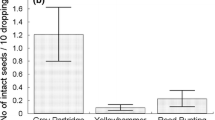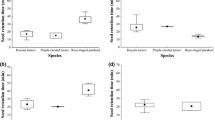Abstract
Effects of avian gut-passage on seed germination are important to assess the effectiveness of frugivores in woodland regeneration, particularly in biodiversity hotspots that have a high incidence of avian frugivory. We examined the effect of avian gut-passage on seed germination in contrast to seeds that remain uneaten in five shrub species in Mediterranean central Chile and sought to determine the physiological mechanism(s) by which seed germinability is modified. Germination assays were conducted in a glasshouse for five common shrub species of the sub-Andean matorral: Azara dentata (Flacourtiaceae), Schinus polygamus and Schinus molle (Anacardiaceae), Cestrum parqui (Solanaceae), and Maytenus boaria (Celastraceae). We estimated germinability (final percent germination), dormancy length (time from sowing to first germination), mean length of dormancy of all germinated seeds, and contrasted germination rates of defecated versus manually extracted and pulp-enclosed seeds. Avian gut-passage increased seed germinability in four of the five shrub species studied—primarily through deinhibition via pulp removal. Minimum dormancy length was not modified by avian gut-passage for A. dentata, but was significantly shorter for S. molle and C. parqui. Mean dormancy length was significantly shorter in gut-passed seeds of A. dentata, S. molle and M. boaria. Avian gut-passage greatly enhanced the seed germination rates of three species, A. dentata, S. molle and C. parqui. We conclude that the positive effects of birds on seed germination facilitate the regeneration of sub-Andean shrublands, and that bird declines due to landscape change may impair recovery rates of successional or restored areas due to dispersal limitation.

Similar content being viewed by others
References
Armesto JJ, Pickett STA (1985) A mechanistic approach to the study of succession in the Chilean matorral. Rev Chil Hist Nat 58:9–17
Armesto JJ, Vidiella PE, Jiménez HE (1995) Evaluating causes and mechanisms of succession in the Mediterranean regions in Chile and California. In: Arroyo MTK, Zedler PH, Fox MD (eds) Ecology and biogeography of Mediterranean ecosystems in Chile, California and Australia. Springer-Verlag, New York, USA, pp 418–433
Arroyo MTK, Rozzi R, Simonetti JA, Marquet PA, Salaberry M (1999) Central Chile. In: Mittermeier R, Myers N, Goettsch-Mittermeier C (eds) Earth’s biologically richest and most endangered terrestrial ecoregions. Cemex, México, pp 161–171
Barnea A, Yom-Tov Y, Friedman J (1990) Differential germination of two closely related species of Solanum in response to bird ingestion. Oikos 57:222–228
Barnea A, Yom-Tov Y, Friedman J (1991) Does ingestion by birds affect seed germination? Funct Ecol 5:394–402
Cipollini ML, Levey DJ (1997) Secondary metabolites of fleshy vertebrate-dispersed fruits: adaptive hypotheses and implications for seed dispersal. Am Nat 150:346–372
Estades CF (2004) Estrategia nacional para la conservación de las aves. Unión de Ornitólogos de Chile y Programa Multidisciplinario de Estudios en Biodiversidad de la Universidad de Chile
Figueroa JA, Jaksic FM (2004) Latencia y banco de semillas en plantas de la región mediterránea de Chile central. Rev Chil Hist Nat 77:201–215
Figueroa JA, Teillier S, Jaksic FM (2004) Composition, size and dynamics of the seed bank in a Mediterranean shrubland of Chile. Austral Ecol 29:574–584
Figueroa JA, Cavieres LA, Gómez-González S, Molina Montenegro M, Jaksic F (2009) Do heat and smoke increase emergence of exotic and native plants in the matorral of central Chile? Acta Oecol 35:335–340
Fuentes ER, Otaíza RD, Alliende MC, Hoffmann AJ, Poiani A (1984) Shrub clumps of the Chilean matorral vegetation: structure and possible maintenance mechanisms. Oecologia 62:405–411
Garwood NC (1983) Seed germination in a seasonal tropical forest in Panama: a community study. Ecol Monogr 53:159–181
Hoffmann A (1998) El árbol urbano de Chile, 3rd edn. Fundación Claudio Gay, Santiago, Chile
Hoffmann AJ, Armesto JJ (1995) Modes of seed dispersal in the Mediterranean regions in Chile, California and Australia. In: Arroyo MTK, Zedler PH, Fox MD (eds) Ecology and biogeography of Mediterranean ecosystems in Chile, California and Australia. Springer-Verlag, New York, USA, pp 289–310
Hoffmann AJ, Teillier S, Fuentes ER (1989) Fruit and seed characteristics of woody species in Mediterranean-type regions of Chile and California. Rev Chil Hist Nat 62:43–60
Howard LF, Minnich RA (1989) The introduction and naturalization of Schinus molle (pepper tree) in Riverside, California. Landsc Urban Plan 18:77–95
Iponga DM, Milton SJ, Richardson DM (2009) Reproductive potential and seedling establishment of the invasive alien tree Schinus molle (Anacardiaceae) in South Africa. Austral Ecol 34:678–687
Izhaki I, Safriel UN (1990) The effect of some Mediterranean scrubland frugivores upon germination patterns. J Ecol 78:56–65
Jaksic F (2001) Spatiotemporal variation patterns of plants and animals in San Carlos de Apoquindo, central Chile. Rev Chil Hist Nat 74:477–502
Jiménez HE, Armesto JJ (1992) Importance of the soil seed bank of disturbed sites in Chilean matorral in early secondary succession. J Veg Sci 3:579–586
Jordano P, García C, Godoy JA, García-Castaño JL (2007) Differential contribution of frugivores to complex seed dispersal patterns. Proc Natl Acad Sci USA 104:3278–3282
Keeley JE (1995) Seed-germination patterns in fire-prone Mediterranean climate regions. In: Arroyo MTK, Zedler PH, Fox MD (eds) Ecology and biogeography of Mediterranean ecosystems in Chile, California and Australia. Springer-Verlag, New York, USA, pp 239–273
Kelly D, Ladley JJ, Robertson AW (2004) Is dispersal easier than pollination? Two tests in New Zealand Loranthaceae. New Zealand J Bot 42:89–103
Linnebjerg JF, Hansen DF, Olesen JF (2009) Gut passage effect of the introduced red-whiskered bulbul (Pycnonotus jocosus) on germination of invasive plant species in Mauritius. Austral Ecol 34:272–277
Myers N, Mittermeier RA, Mittermeier CG, da Fonseca GAB, Kent J (2000) Biodiversity hotspots for conservation priorities. Nature 403:853–858
Nathan R (2006) Long-distance dispersal of plants. Science 313:786–788
Paulsen TR, Högstedt G (2002) Passage through bird guts increases germination rate and seedling growth in Sorbus aucuparia. Funct Ecol 16:608–616
Randall RP (2002) A global compendium of weeds. RG and FJ Richardson, Melbourne, Australia
Reid S (2008) Interaction dynamics of avian frugivores and plants in a subAndean sclerophyllous shrubland of central Chile: implications for seed dispersal and regeneration patterns. PhD Dissertation, Pontificia Universidad Católica de Chile, Santiago, Chile
Reid S, Armesto JJ (2010) Interaction dynamics of avian frugivores and plants in a Chilean Mediterranean shrubland. J Arid Environ
Robertson AW, Trass A, Ladley JJ, Kelly D (2006) Assessing the benefits of frugivory for seed germination: the importance of the deinhibition effect. Funct Ecol 20:58–66
Russo SE, Portnoy S, Augspurger CK (2006) Incorporating animal behaviour into seed dispersal models: implications for seed dispersal. Ecology 87:3160–3174
Sala OE, Chapin FS, Armesto JJ, Berlow E, Bloomfield J, Dirzo R, Huber-Sanwald E, Ehuenneke LF, Jackson RB, Kinzig A, Leemans R, Lodge DM, Mooney HA, Oesterheld M, Poff NL, Sykes MT, Walker BH, Walker M, Wall DH (2000) Global biodiversity scenarios for the year 2100. Science 287:1770–1774
Samuels IA, Levey DJ (2005) Effects of gut passage on seed germination: do experiments answer the questions they ask? Funct Ecol 19:365–368
Schupp EW (1993) Quantity, quality and the effectiveness of seed dispersal by animals. In: Fleming TH, Estrada A (eds) Frugivory and seed dispersal: ecological and evolutionary aspects. Kluwer Academic, Dordrecht, The Netherlands, pp 15–29
Skarpaas O, Dauer JT, Schwarz CM, Rauschert EJ, Jongejans E, Jabbour R, Mortensen DA, Isard SA, Lieb DA, Sezen Z, Hulting AJ, Ferrari MJ, Shea K, Long ES (2007) Dispersal: towards unification across organisms and research traditions. Movement ecology symposium, 92nd annual meeting of the ecological society of America. San Jose, California, 4–10 Aug 2007
Traveset A (1998) Effect of seed passage through vertebrate frugivores’ guts on germination: a review. Perspect Plant Ecol Evol Syst 1:151–190
Traveset A, Verdú M (2002) A meta-analysis of the effect of gut treatment on seed germination. In: Levey DJ, Silva WR, Galetti M (eds) Seed dispersal and frugivory: ecology, evolution and conservation. CABI Publishing, Wallingford, UK, pp 339–350
Traveset A, Riera N, Mas RE (2001) Passage through bird guts causes interspecific differences in seed germination characteristics. Funct Ecol 15:669–675
Traveset A, Robertson AW, Rodríguez-Pérez J (2007) A review on the role of endozoochory in seed germination. In: Dennis AJ, Schupp EW, Green RJ, Westcott DW (eds) Seed dispersal: theory and its application in a changing world. CABI Publishing, Wallingford, UK, pp 78–101
Acknowledgments
We thank Juan Luis Allendes, Julio Cortés, Miguel Jordan, Natalia Lahsen, Daniel Naya, Sergio Silva, and Carlos Roveraro for research assistance. Mary Willson and Ximena Nelson made valuable comments on an earlier version of the manuscript. Support for this project was provided by a doctoral fellowship from the Comisión Nacional de Investigación Científica y Tecnológica (CONICYT AT-24050097) to S. Reid, and grants FONDECYT-FONDAP 1501-0001 (Programs 2 and 3) to the Center for Advanced Studies in Ecology and Biodiversity, Pontificia Universidad Católica de Chile; Iniciativa Científica Milenio (Mideplan), under contract P05-002 to the Institute of Ecology and Biodiversity (IEB), and ReForLan Project INCO-EC-2007 (FP6).
Author information
Authors and Affiliations
Corresponding author
Rights and permissions
About this article
Cite this article
Reid, S., Armesto, J.J. Avian gut-passage effects on seed germination of shrubland species in Mediterranean central Chile. Plant Ecol 212, 1–10 (2011). https://doi.org/10.1007/s11258-010-9796-8
Received:
Accepted:
Published:
Issue Date:
DOI: https://doi.org/10.1007/s11258-010-9796-8




